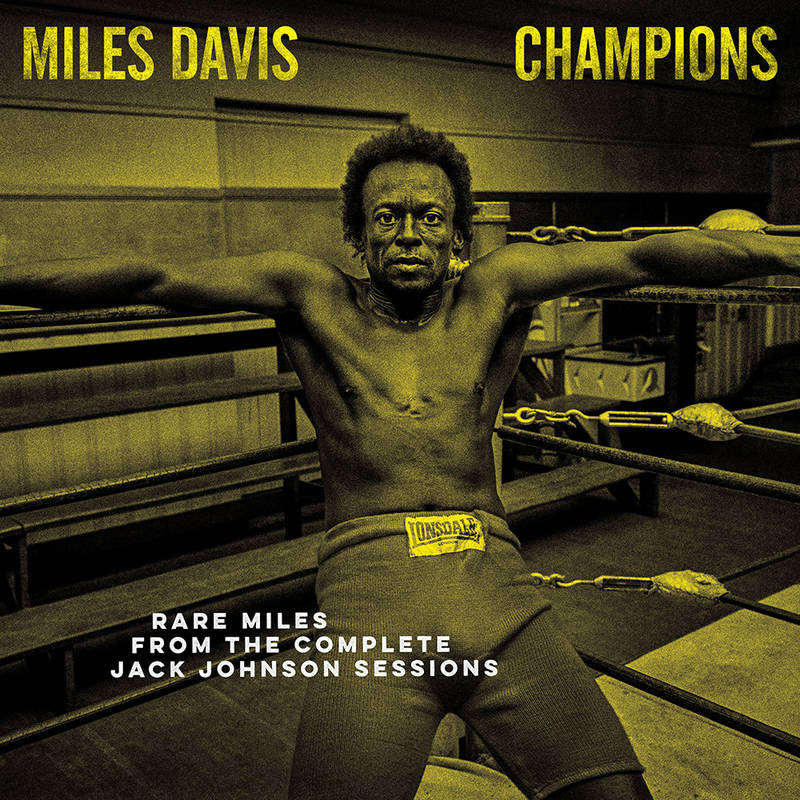
The new RSD Drops lists came out April 7th for both the June 12th and the July 17th Drops. Similar to 2020, Record Store Day is being split into multiple dates to help with crowding in the stores. I think this also helps with the vinyl pressing delays as the record manufacturing is still catching up from the COVID shutdowns and related problems.
As I predicted in my post last year about the excellent Double Image: Rare Miles from the Complete Bitches Brew Sessions 2 LP release, the next in the series is one based on the 1970 sessions that resulted in the Jack Johnson (AKA A Tribute To Jack Johnson) album. Titled Champions – Rare Miles from the Complete Jack Johnson Sessions, it will come out for the second RSD Drops on July 17th, and will be around $21.97 according to Bull Moose, and will be on opaque yellow vinyl.
According to the expert in all things Electric Miles, Paul Tingen, Davis was spurred on by his recent exposure to Jimi Hendrix to state in a 1969 Rolling Stone interview, “I could put together the greatest rock ‘n roll band you ever heard.” Tingen surmises that Davis seeing Hendrix’s Band of Gypsies at the Fillmore East New Years Day, 1970 was the biggest catalyst for his new sound.
Davis was in the Columbia studios with his band for a marathon 12 dates starting February 18th and continuing through June 4th– an incredibly productive time for Davis yielding many more recordings than the two that ended up on the 1971 LP. Distilling the massive amount of time in the studio for Davis into releases that make sense organizationally continues to be a challenge, and has since the beginning involved some creativity on the part of the record producers and the label. This is compounded by the fact that Davis rolled tape for every minute he was in the studio.
Following the sessions that would form Bitches Brew (August 19th-21st, 1969) Davis continued recording music that followed the new electric Jazz/Funk path he was taking. The compilers of the Complete Bitches Brew opted to take sessions from November 1969 through to February 1970 that used the same band lineup as Bitches Brew. In that regard, the Double Image release is less of an outtakes of Bitches Brew as it is maybe a part II.
The Complete Jack Johnson Sessions pretty much pick up where The Complete Bitches Brew Sessions drop off. “Take It Or Leave It” was recorded on February 2nd, and the initial “Willie Nelson” sessions start just over two weeks later on February 18th.
Side A
1. “Duran – Take 4” (March 17, 1970 at Columbia Studio C)
2. “Sugar Ray” (March 20, 1970 at Columbia Studio B)
3. “Johnny Bratton Take 4” (February 27, 1970 at Columbia Studio B)
Side B
1. “Ali – Take 3” (May 19, 1970 at Columbia Studio C)
2. “Ali – Take 4” (May 19, 1970 at Columbia Studio C)
3. “Right Off – Take 11” (April 7, 1970 at Columbia Studio B)
As an entry in the catalog of Miles Davis music, The Complete Jack Johnson Sessions represent a transitional snapshot. These are the sound of Davis and his sidemen searching. Big looped sections on the eventual album from these sessions show the band landing blocks of music that work, but also seems to include the band kind of reaching. A lot of this was a result of the very unstructured approach in the studio. From the Tingen article:
“Everything was experimentation,” recalled drummer Billy Cobham. “There was not one moment that whatever was put on a piece of paper would not be changed.” “A lot of times the way we did things was very fragmented,” added Dave Holland. “Often I didn’t know whether we were recording or rehearsing. We would have these fragments, these sketches of ideas, and we’d play them for 10 minutes. And then we might do one more take like that, and move on to the next thing. One of the things that created the sound of the studio recordings is that were all trying to figure out what was going on. This created a certain space—it wasn’t tentative, but it was searching. And Miles had a policy of taping everything. When it was then finally put together, there was a lot of editing that went on.”
Even with this somewhat randomly-organized recording, the highlight is Davis, who plays some fantastic runs around the grooves. This seems to be a result the physical and mental health of Davis during this time. The cover of Champions is a photograph of Davis in the ring taken by Jim Davis shortly after these sessions. Tingen quotes Chick Corea, “Miles was, “totally clean, working out in the gym, physically looking great, and living the life of a health freak. He had this thing about fish and told me how good fish was for you.” In short, Miles was in great physical and mental shape, and at the peak of his trumpet powers.”
In the Davis catalog, Jack Johnson is a record that is somewhat obscure; maybe “obscured” is a more accurate description. Even though it uses a similar approach of editing miles of tape into a two-track epic funk, it is overshadowed by achievements of Bitches Brew. The Champions collection of tracks from these sessions helps put some context around somewhat meandering Jack Johnson album and also opens the door for the following Electric albums which include my personal favorites Big Fun and On The Corner.
Speaking of On The Corner, it’s almost certain that the next RSD-exclusive title based on the series of “Complete Sessions” for Miles Davis will be from the 2007 Complete On The Corner Sessions made up of sessions from June of 1972 through May of 1975.
